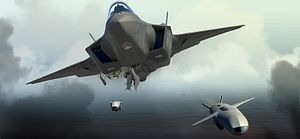A missile specifically designed for the F-35 Joint Strike Fighter was successfully tested last week at the Utah Test and Training Range in Utah’s West Desert in the Western United States.
According to a press release by Norwegian defense contractor Kongsberg, which is jointly developing the Joint Strike Missile (JSM) with Raytheon, the missile was launched from a F-16 at 22,000 feet and performed “a number of challenging flight maneuvers.”
The JSM–designed to fit inside the F-35A Joint Strike Fighter’s missile bay in order to maintain the stealth capabilities of the aircraft– is a fifth-generation, long-range, precision-guided, stand-off missile system and can be deployed in anti-surface warfare and naval fire support missions.
The recent test showed the technological maturity of the missile including its software, Kongsberg underlines. “This is a major accomplishment for the JSM program, and in addition several critical capabilities beyond the scope of the test were verified. The test demonstrates that we are on track with the qualification of JSM, which brings critical capability to F-35 and the warfighter,” says Harald Ånnestad, the president of Kongsberg Defense Systems.
Flight tests of the JSM, derived from the Naval Strike Missile (NSM) are slated to continue into 2016 and 2017. Once in service, the JSM will be the only anti-ship missile that can be accommodated by the F-35’s weapons bay. “This successful flight test further validates that JSM will be an ideal solution for the medium-range anti-ship and land attack mission,” said Mike Jarrett, Raytheon Missile Systems vice president of Air Warfare Systems.
As I reported previously (See: “Australia and Norway to Work Together on Missile”), in February 2015, BAE Systems Australia and Kongsberg signed a co-operative agreement to jointly develop an independent missile sensor to detect and identify hostile radars.
According to Raytheon features of the missile include advanced engagement planning system that exploits the geography in the area; accurate navigation system for flight close to terrain; high maneuverability to allow flight planning in close vicinity to land masses; discriminating seeker with imaging infrared technology; two-way networking datalink (compliant with standard military equipment) offering target-update; as well retargeting and mission-abort capabilities.
The missile will also be modified to fit the U.S. Navy’s and U.S. Marine Corps’ F-35 variants. As I wrote in March 2014 (See: “Oops: US Close Air-Support Bomb Doesn’t Fit on the F-35”), the Pentagon discovered earlier this year that the precision-guided air-dropped Small Diameter Bomb II (SDB II) does not fit onto Joint Strike Fighter Marine Corps variant without modifications to the aircraft’s weapons bay.































